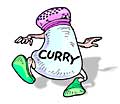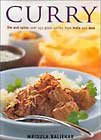|
|
 Curry: A Spice For All Seasons Curry: A Spice For All Seasons
by Marjorie Dorfman
Curry is probably the most confusing spice in the history of the world, both in terms of its origins and in its definition. What do we mean by curry? If this question isn’t annoying enough, read on for some equally annoying answers.
|
Beef, mutton, rabbit, if you wish,
Lobsters, prawn or any kind of fish,
Are fit to make a curry. ‘Tis when done,
A dish for Emperors to feed upon. – William Makepeace Thackeray
Curry is probably the most confusing spice in the history of the world, both in terms of its origins and in its definition. What do we mean by curry? If this question isn’t annoying enough, read on for some equally annoying answers.
I’m sure you will be thrilled to learn that the word curry means severl things, all equally maddening. Is curry some horse-drawn contraption that claims to have fringe on top? Are we talking about a blend of exotic spices or something one uses to groom horses?
 Whether it’s one or none of those, most experts agree that the word curry is most likely southern Indian in origin. It can be traced to the Tamil language, where the word kari, means either soup or spiced sauce, depending on which source is consulted. According to Indian legend, Buddha (Shaka) was the first to cook curry, mixing it into nuts and fruits. At first, it was considered a miraculous way to achieve eternal youth and longevity. Only later did it become popular as a seasoning. Some legends refer to it as Coory, while others call it Curry. The moral of the story is that a rose by any other name can still be one spicy meatball!
Whether it’s one or none of those, most experts agree that the word curry is most likely southern Indian in origin. It can be traced to the Tamil language, where the word kari, means either soup or spiced sauce, depending on which source is consulted. According to Indian legend, Buddha (Shaka) was the first to cook curry, mixing it into nuts and fruits. At first, it was considered a miraculous way to achieve eternal youth and longevity. Only later did it become popular as a seasoning. Some legends refer to it as Coory, while others call it Curry. The moral of the story is that a rose by any other name can still be one spicy meatball!
The problem is and, aye this really is the rub, that there is just as much evidence floating around to suggest that the word curry has English roots. When British merchants landed in India in the early 17th century, the word cury had been a part of the English language for well over two hundred years. In fact, it was even recorded that the Emperor’s meal of fowl stewed in butter with spices and almonds served to the merchants in 1612 was very similar to a recipe for English Chicken Pie found in the cook book, The English Hus-Wife by Gevase Markham, which was very popular at the time. So which really did come first, the spicy English chicken or the hot Indian egg?
 According to Peter and Colleen Grove, hot spices were first brought to Britain from the Middle East in the twelfth century after Richard the Lion-Heart (aka Richard I’s) crusades. Under his rule, there was a revolution in English cooking. Ginger, cinnamon, nutmeg, cloves, coriander, cumin and cardamom were all being used by the cooks in the kitchens of the wealthier Brits, resulting in a highly spiced cuisine very similar to Indian. These chefs also produced a powder fort, powder douce and a powder blanch. During the reign of Richard II, (1377-1399) the first English cookbook was written. The King employed some two hundred cooks and they plus others produced a work of one hundred and ninety six recipes in 1390 entitled, The Forme of Cury. Although cury was an old English word for cuisine, it soon became associated with the hot dishes of the time.
According to Peter and Colleen Grove, hot spices were first brought to Britain from the Middle East in the twelfth century after Richard the Lion-Heart (aka Richard I’s) crusades. Under his rule, there was a revolution in English cooking. Ginger, cinnamon, nutmeg, cloves, coriander, cumin and cardamom were all being used by the cooks in the kitchens of the wealthier Brits, resulting in a highly spiced cuisine very similar to Indian. These chefs also produced a powder fort, powder douce and a powder blanch. During the reign of Richard II, (1377-1399) the first English cookbook was written. The King employed some two hundred cooks and they plus others produced a work of one hundred and ninety six recipes in 1390 entitled, The Forme of Cury. Although cury was an old English word for cuisine, it soon became associated with the hot dishes of the time.
 There seems no doubt that whatever its origins, the spread of curry from India is inextricably linked to the presence of the British Raj, whose army personnel and civil servants acquired a taste for spicy food while living there. They brought their newly discovered dishes home and adapted them to suit their own tastes. Hence, Mulligatawny soup, for example, is an anglicized version of its more pungent Indian forbear. Similarly, kedgeree was originally a rice and lentil dish, but was adapted by the British as a breakfast fish platter. The British liked the flavors so much that spices were regarded as incredibly valuable and housed in The Tower of London! (It is not known if they were kept near the guillotine and the spirits of those spicy souls who lost their heads throughout the tower’s bloody history.)
There seems no doubt that whatever its origins, the spread of curry from India is inextricably linked to the presence of the British Raj, whose army personnel and civil servants acquired a taste for spicy food while living there. They brought their newly discovered dishes home and adapted them to suit their own tastes. Hence, Mulligatawny soup, for example, is an anglicized version of its more pungent Indian forbear. Similarly, kedgeree was originally a rice and lentil dish, but was adapted by the British as a breakfast fish platter. The British liked the flavors so much that spices were regarded as incredibly valuable and housed in The Tower of London! (It is not known if they were kept near the guillotine and the spirits of those spicy souls who lost their heads throughout the tower’s bloody history.)
Curries have been made for centuries in India, both as part of a staple diet and as a highly sophisticated cuisine. There are vast regional variations, but the cuisine of any area is intimately linked with its whole history. The conquest of new lands, being colonized by foreigners, migrations and patterns of trade all bring new influences to bear upon how people cook and the ingredients they use. In Goa, for example, the various Hindu, Muslim and Portuguese influences have merged over the centuries to become the distinctive Goan cuisine of today. The famous vindaloo was originally a Portuguese dish altered over time to accommodate local tastes and ingredients.
The term curry generally categorizes a large set of soup or stew preparations nearly always containing ginger, garlic, onion, turmeric, chile and oil. Various curries are indigenous to several Asian countries including India, Sri Lanka (Ceylon), Myanmar (Burma), Thailand, Malaysia and Indonesia. They differ greatly in taste and content, not only between the countries but also within the countries. In addition, no two cooks prepare food the same way. Each has his or her unique style, which adds an individual touch to every meal. Not all curries are hot as is generally believed. There are, in fact, more mild curry recipes than hot ones. In Indian cuisine, the hot vindaloo and Madras curries and the mild kormas vividly demonstrate this contrast.
 In Thai, Malaysian and Indonesian curries, shrimp paste as well as coconut or coconut milk are used regularly. In these countries curries can also be hot or mild and due to the coconut content are often sweet as well. Lime and basil leaves, which render very distinctive flavorings, are often added. In SriLanka, spices are roasted and meat items like chicken are skinned before cooking. Both of these factors greatly affect the flavor of a curry. In Burma, curries are based on garlic, ginger, onions and chilies and are generally watery and delicately flavored. Some curry recipes in Asian countries date back several hundred years and many meals we take for granted today were once the sole reserve of royalty and the very rich.
In Thai, Malaysian and Indonesian curries, shrimp paste as well as coconut or coconut milk are used regularly. In these countries curries can also be hot or mild and due to the coconut content are often sweet as well. Lime and basil leaves, which render very distinctive flavorings, are often added. In SriLanka, spices are roasted and meat items like chicken are skinned before cooking. Both of these factors greatly affect the flavor of a curry. In Burma, curries are based on garlic, ginger, onions and chilies and are generally watery and delicately flavored. Some curry recipes in Asian countries date back several hundred years and many meals we take for granted today were once the sole reserve of royalty and the very rich.
Curry powder is made from a mixture of ten to twenty different kinds of spices which create complex aromas that stimulate the appetite and give curry both its color and taste. Turmeric, saffron and paprika create color. The hot taste bursts forth from chili (red pepper), white pepper, black pepper, garlic, ginger and mustard. Aroma and flavor are created by the addition of cumin, coriander, cinnamon, laurel, nutmeg, mace, fennel, allspice, cardamom and clove. Could I possibly have left any spice out of this hot melange?
Curries provide many health giving properties as well as vitamins and protein added by the meals. Fresh vegetables are often included in curries providing many nutritional benefits. There are many ready made curry powders and sauces available on the market today, but nothing can beat the taste of one prepared with fresh herbs and spices. Acquainting oneself with the world of curry is a matter of trial and error. It is better to start with the milder ones, especially if your palette is not accustomed to hot spicy food. Work your way up, as the saying goes. Just remember that the tongue you save may be your own!

your meals!!
|
|
|
|
 |
|
|
Zenobia Nuts
We used to order from Zenobia Company back in the sixties. Delighted to find them online.

Free Express Shipping on Delicious Roasted and Salted Cashews
Click Here!
|
Don't miss these excellent books:
Curry: Fire and Spice
Over 50 Great Curries from India and Asia
by Mridula Baljekar

This comprehensive and informative cookery guide examines the history of curries in India and around the world. If you are looking for an easy to use authentic curry cookbook, then do not hesitate to buy this one.
Great Curries of India
by Camellia Panjabi

Panjabi's guide is as beautiful to look at as it is a delight to read. Just how ingredients are combined to achieve the complex, savory tastes associated with fine curries is explained here in detail. Highlighted are recipes for dishes not found on most restaurant menus. This superior introduction for cooks unfamiliar with Indian food is also a definitive guide for connoisseurs on a quest to produce flavorful curries in their own kitchens.
|

Click for a printer friendly version of this article.
|
|